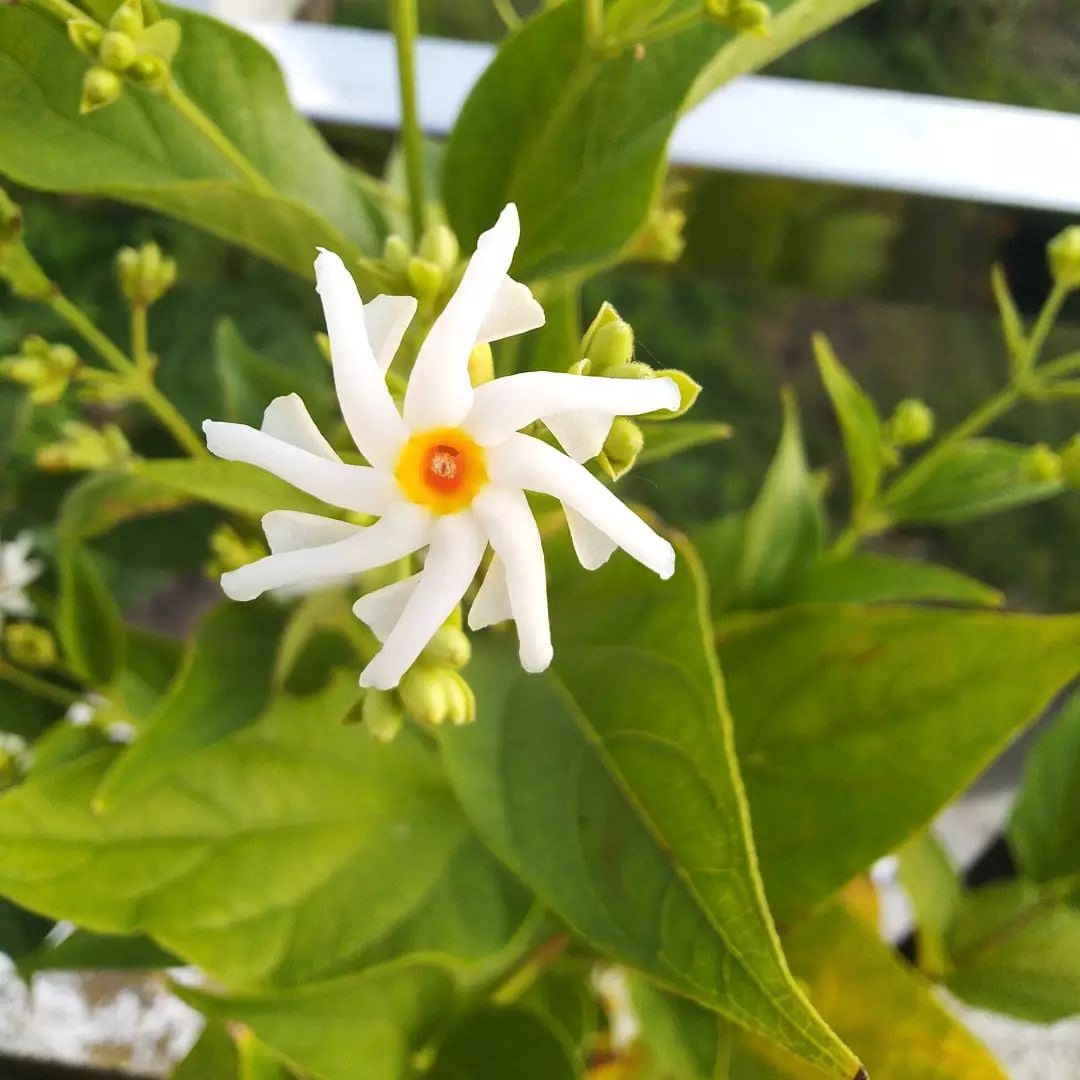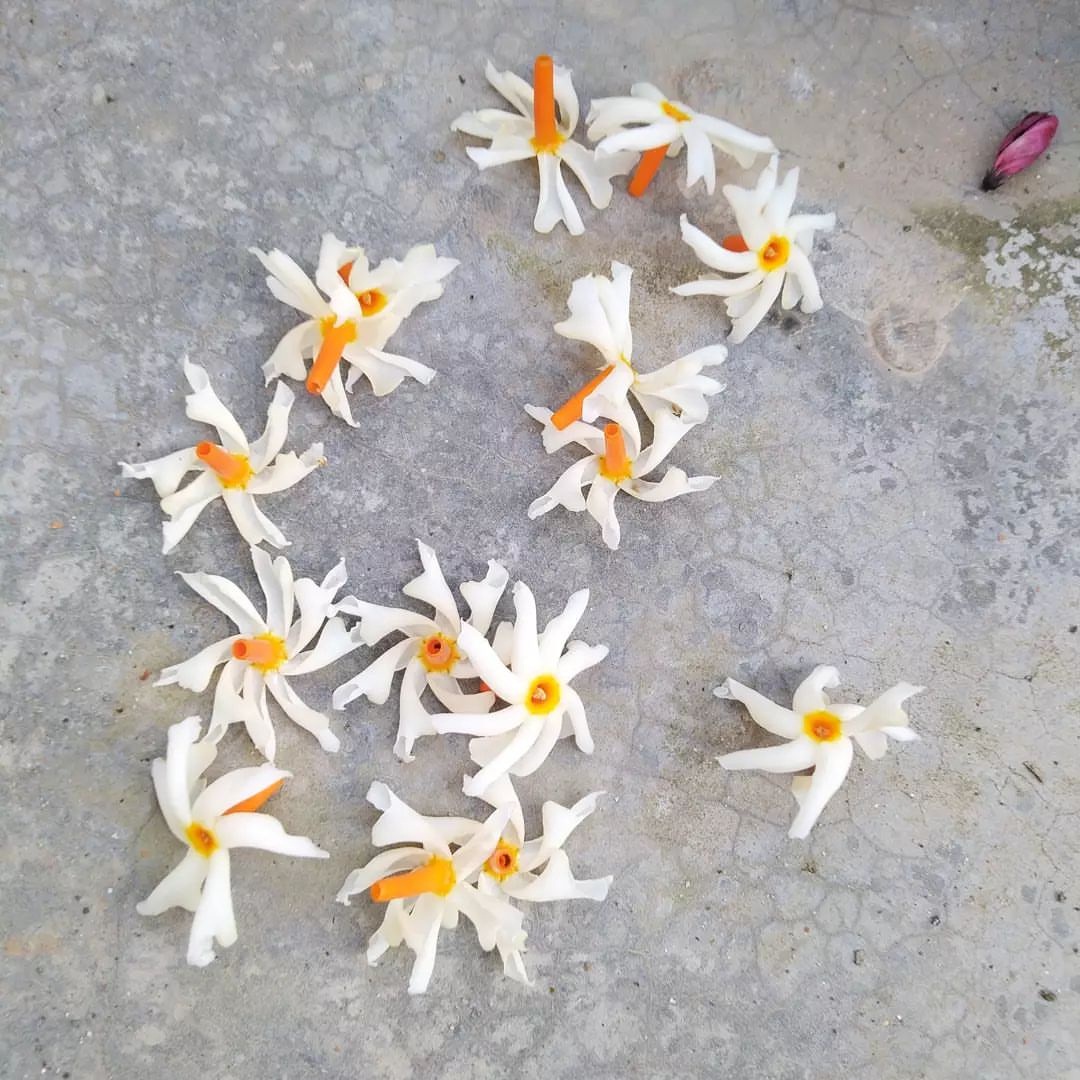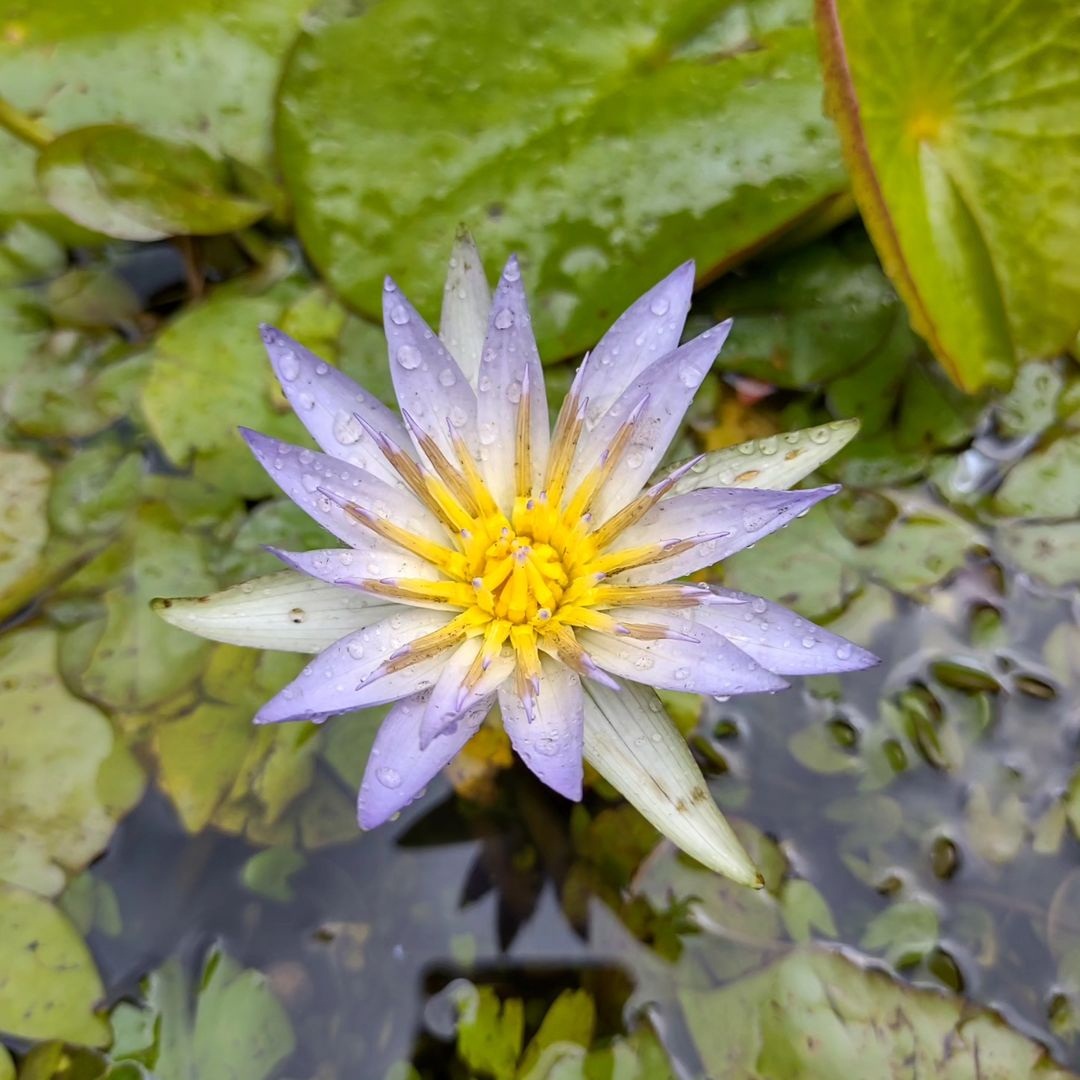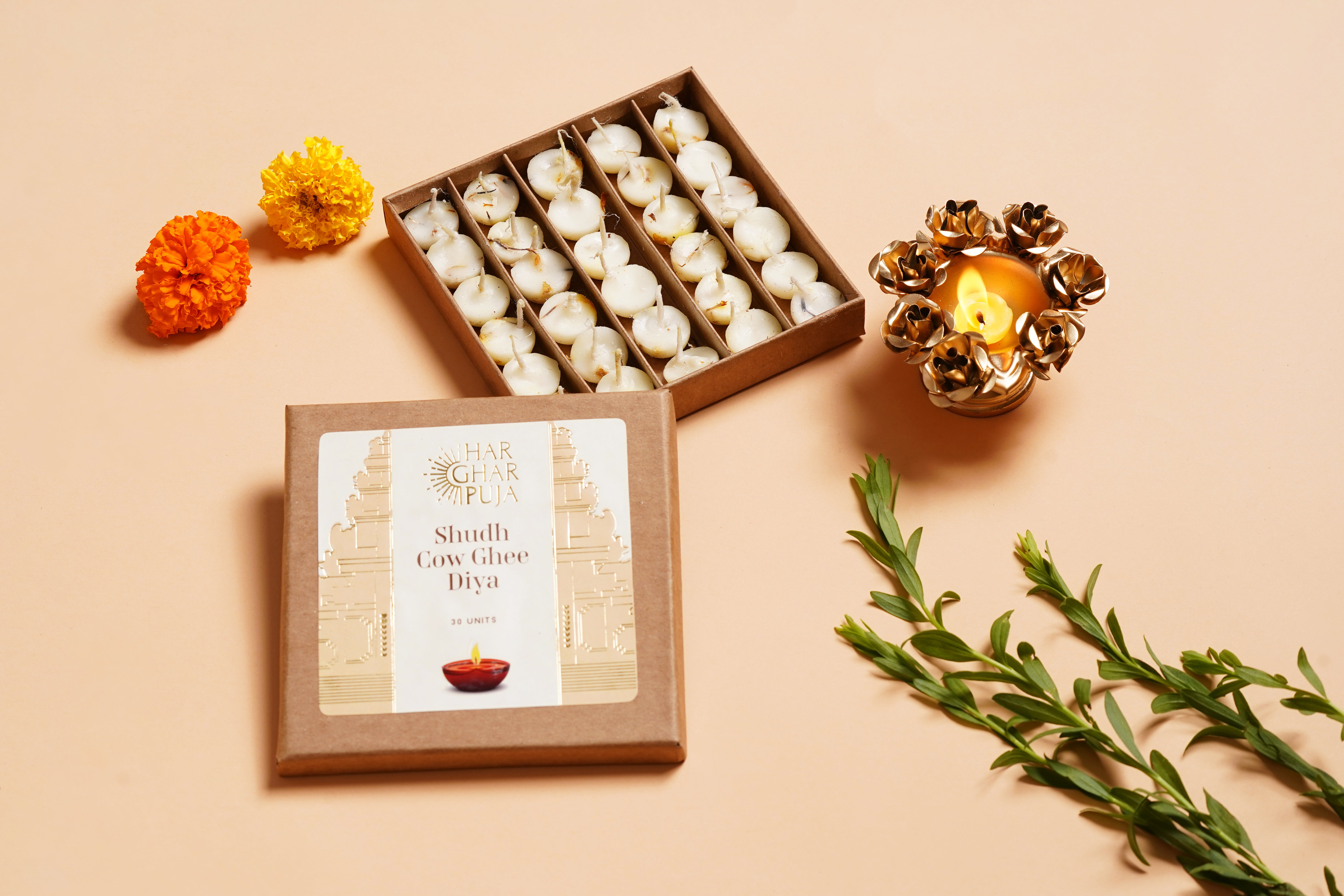The Bhagavad Gita, renowned for its profound spiritual teachings, intricately weaves the symbolism of flowers into its verses to impart timeless wisdom. In today’s fast-paced digital era, these floral metaphors from ancient scriptures serve as guiding lights, offering insights into stability, simplicity, and spiritual growth amidst life’s uncertainties. Let’s delve into the symbolism and significance of ten flowers mentioned in the Bhagavad Gita and other Hindu texts, unraveling the profound spiritual truths they embody.
1. Harsingar/Parijat (Night Jasmine, Nyctanthes arbor-tristis)

The Harsingar or Parijat flower, known for blooming at dusk with its white and orange hues, symbolizes the sacred union of worldly existence and divine knowledge. Mentioned in the Bhagavad Gita, it illustrates the eternal life cycle and themes of rebirth. Mythologically linked to Lord Krishna, it deepens its spiritual significance through tales of divine romance and the dance of the universe.

लक्ष्मी: कौस्तुभ पारिजातक सुरा धन्वंतरिश्चंद्रमा: ।
गाव: कामदुधाः सुरेश्वर गजो, रंभादिदेवांगनाः ।।
अश्वः सप्त मुखोविषम हरिधनुं, शंखोमृतम चांबुधे ।
रत्नानीह चतुर्दश प्रतिदीनम, कुर्वंतु वोमंगलम ।।
Meaning: Goddess Lakshmi, Kaustubh Mani, the Kalpa tree named Paarijaat, Goddess Varuni, Vaidyaraj Dhanvantari, the Moon, the Kamadhenu cow, the Airavat elephant of the king of gods Indra, the Apsaras like Rambha, the seven-headed horse named Uchchaihshrava, the poison called Kalakuta, the Sharnga bow of Lord Vishnu, the Panchajanya conch and the nectar – may these fourteen gems born from the ocean bless you all every day.

Trivia:
Harsingar is a favored flower in Indian weddings, enhancing the beauty of ceremonial venues

2. Champa (Champak, Plumeria, Magnolia / Michelia champaca)

Revered as the ‘fragrance of God’, Champa symbolizes devotion and flexibility in Hindu traditions. Its association with Lord Krishna, who adorned his crown with these flowers during his divine pastimes in Vrindavan, underscores its spiritual depth and the enduring bond between the soul (Atman) and the universal soul (Paramatma)

तस्मादश्वा अजायन्त ये के चोभयादतः ।
गावो ह जज्ञिरे तस्मात्तस्माज्जाता अजावयः (शुक्लयजुर्वेदीय पुरुषसूक्तम् (8))
जाजी चम्पक पुन्नाग केतकी मल्लिकादिभि:
करवीरै: पारिजातै: पूजयामि रमापतिम्:।।
ॐ श्री कृष्ण परब्रह्मणै नम: नानाविध परिमल पत्र पुष्पाणि सर्मपयामि। (श्रीमद् भगवद गीता)
तत्कुड्यस्यैव परितः पुष्पारामांश्चकार ह । मल्लिकाकरवीराब्जकुन्दमन्दारमालती ।। 30।।
तुलसीचम्पकानां च वनान्येव चकार ह । खनित्वा तत्र कूपं तु वर्धयंस्तज्जलैर्वनम् ।। 31।।
पदकह्लारतुलसीचम्पकैर्दामकारिण मदर्चननिमित्तं ये प्रत्यहं श्रद्धयान्विताः ।।12।।
लक्ष्म्या समेतस्तेषां हि गृहे वत्स्याम्यहं सुराः ।
तेषां येऽपि च साहाय्यं कुर्वते श्रद्धयान्विताः ।। १३ ।।
तेषामपि सदा सम्पत्प्रदोऽहं कमलासन ! (श्रीवेङ्कटाचलमाहात्म्यम्)
Meaning: On Earth, those pious people who offer me golden ornaments studded with Vajra-Nikunai, get beautiful, graceful, learned, religious and extremely long-lived sons and endless wealth effortlessly by my will.
Out of devotion to me, those who make garlands of Padma Kankaar, Tulsi, Champa etc. daily, I always reside in their house along with Goddess Lakshmi and those who help them, I also provide them with lots of wealth and property.

तदानीं देवदेवेन स्वयमाज्ञापितो नृपः । तिन्त्रिणीं चम्पकं चोभौ पालयैतौ नगोत्तमौ ।। ४४ ।।
मम चास्थानिकी चि-चा लक्ष्म्याः स्थानं च चम्पकः । नमस्कायौं नृपैस्तौ हि ऋषिदेवनरैः सदा ।। (श्रीवेङ्कटाचलमाहात्म्यम्)
Meaning: Then the Lord himself commanded the king to respect (not cut) the two trees named Tamarind and Champak. Tamarind is my place and Champak is the place of Goddess Lakshmi. They are always revered by sages, gods, humans and kings.
The golden-yellow petals of Champa symbolize hope and everlasting faith, a feeling strengthened by the association of this flower with Lord Shri Krishna, who is the guide and director of the entire universe.

3. Lotus (Kamal – Nelumbo nucifera)

Central to Hindu philosophy, the Lotus signifies purity, hope, and detachment. Described in the Bhagavad Gita as a metaphor for spiritual elevation, its emergence from muddy waters into the sunlight mirrors the soul’s journey from ignorance to enlightenment.

Lord Vishnu and Brahma are often depicted seated on the lotus, symbolizing creation and prosperity.

ब्रह्मण्याधाय कर्माणि सङ्गं त्यक्त्वा करोति यः।
लिप्यते न स पापेन पद्मपत्रमिवाम्भसा।।5.10।। (श्रीमद् भगवदगीता)

Meaning: Those who give up all attachment and surrender their actions to God remain untouched by sin just as the lotus leaf remains untouched by water.

4. Kanak Champa (Karnikar – Pterospermum acerifolium)

Kanak Champa, celebrated for its elegant petals, is associated with Lord Krishna, enhancing the imagery of his divine attire. Its golden-yellow blooms evoke themes of beauty in spirituality and the deep connection between the Lord and his devotees.

बर्हापीडं नटवरवपुः कर्णयोः कणिकारं
विभ्रद्वासः कनककपिशं वैजयन्तीं च मालाम्।
रन्ध्रान् वेणोरधरसुधया पूरयन् गोपवृन्दै-
र्वृन्दारण्यं स्वपदरमणं प्राविशद् गीतकीर्तिः।।
(Bhagavad Gita Chapter 21 Canto 10 Verse 5)

Meaning: Shri Krishna is entering Vrindavan along with the cowherd boys. He is wearing a peacock feather on his head, yellow oleander flowers on his ears, a beautiful yellow cloth is adorning his body and around his neck he is wearing a Vaijayanti garland of beautiful fragrant flowers.

5. Madhavi (Madhavi Lata, Hiptage – Helicopter Flower – Hiptage benghalensis)

The Madhavi creeper symbolizes spiritual longing and the intricate dance of creation and dissolution. Linked to Lord Vishnu, known as Madhava, and mentioned in ancient texts like the Vishnu Purana and Kalidasa’s works, it embodies the soul’s quest for liberation (moksha).

Kalidasa also mentioned Madhavi Lata in his classic drama ‘Abhijnana Shakuntalam’.

‘When Sage Kanva learnt that his daughter Shakuntala had chosen King Dushyanta as her husband, he said that he had been searching for a beautiful mango tree (referring to Dushyanta) for a long time and now he would marry his Madhavi creeper (Shakuntala).’
Another name for Madhavi Latha is ‘Atimukta’, which means ‘completely liberated’, reminding us of the ultimate goal of every soul, which goes through the complexities of life and always seeks liberation or ‘moksha’.
6. Kewda (Ketaki – Pandanus odoratissimus)

Known for its fragrance, Kewda holds religious significance in Hindu rituals and scriptures. Mentioned in the Bhagavad Gita, it signifies devotion and the offering of nature to the divine, enhancing its spiritual importance in Hindu worship practices.

पत्रं पुष्पं फलं तोयं यो मे भक्त्या प्रयच्छति |
तदहं भक्त्युपहृतमश्नामि प्रयतात्मन:

Meaning: “If someone offers Me a leaf, a flower, a fruit, or water with love and devotion, I accept it.” (Srimad Bhagavad Gita 9.26)

The Kevada flower is also related to that ancient religious story in which Lord Shiva had forbidden the Kevada flower from his worship. Other characters of this story also included Lord Vishnu and Brahma. Due to this, the religious importance of Ketaki flower increases.
7. Neel Kamal (Blue Water Lily – Nymphaea nouchali)

Rising from deep waters, the Neel Kamal symbolizes purity, peace, and spiritual transcendence. Its presence in Hindu scriptures reflects its role in spiritual growth and the journey towards enlightenment, resonating with themes of resilience and spiritual enlightenment.

भीष्मद्रोणतटा जयद्रथजला गान्धारनीलोत्पला
शल्यग्राहवती कृपेन वहनी कर्णेन वेलाकुला।
अश्वत्थामविकर्णघोरमकरा दुर्योधनावर्त्तिनी
सोत्तीर्णा खलु पान्डवै रणनदी कैवर्तकः केशवः ॥6॥ (गीता ध्यानम् – भाग 2 – 67)

Meaning: With Keshav as their leader, the Pandavas crossed the river of war whose banks were Bhishma and Drona, whose waters were Jayadratha, whose blue lotus was the King of Gandhara, Shakuni, whose crocodiles were Shalya, whose current was Kripacharya, whose waves were Karna, whose terrible crocodiles were Vikarna and Ashwatthama, and whose whirlpool was Duryodhana.

This sentiment is also echoed in one of India’s greatest epics, the Ramayana, where the blue lotus’s significance is further enhanced by its bright colour. In the Ramayana, it is associated with purity and commitment. Its connection to Lord Shiva further enhances its religious significance.

8. Bhandhook (Midday Flower – Pentapetes phoenicea)

The vibrant Bhandhook flower, which blooms at midday, symbolizes intense moments of life and the presence of the divine. Associated with Lord Krishna and Lord Ganesha, it represents passion, wisdom, and the divine rhythms governing the universe.

Reflecting the life-giving essence of the Sun God, the flower’s midday bloom symbolizes the energy of life, its cycles and the divine rhythms that govern the universe.
10. Marigold (Genda, Calendula)

Vibrant and energetic, Marigold flowers symbolize auspiciousness and happiness in Hindu traditions. Offered to deities like Lord Krishna, they embody love, devotion, and grace, enhancing their significance in religious ceremonies and festive decorations.

The scriptures describe marigold flowers as being offered to Krishna, symbolizing love, devotion and grace.
देवताभ्यः सुमनसो यो ददाति नरः शुचिः ।
तस्मात्सुमनसः प्रोक्ता यस्मात्तुष्यन्ति देवताः
(Mahabharata Book 13, Anushasana Parva Chapter 101, Verses 19-21)

Meaning: “Flowers please the mind and provide prosperity. Therefore, men performing religious deeds named them Suman.”

Through these ten flowers, the Bhagavad Gita and Hindu texts illuminate profound spiritual truths. They teach us to appreciate the beauty of nature, reflect on life’s transient nature, and embrace the enduring principles of love, detachment, and self-awareness. In a world filled with challenges, these floral metaphors offer timeless wisdom, guiding us on a path of spiritual growth and deeper understanding of our existence. As we immerse ourselves in their symbolism, we uncover layers of religious devotion and universal truths hidden within each petal, inviting us to contemplate the divine intricacies of life and creation.







